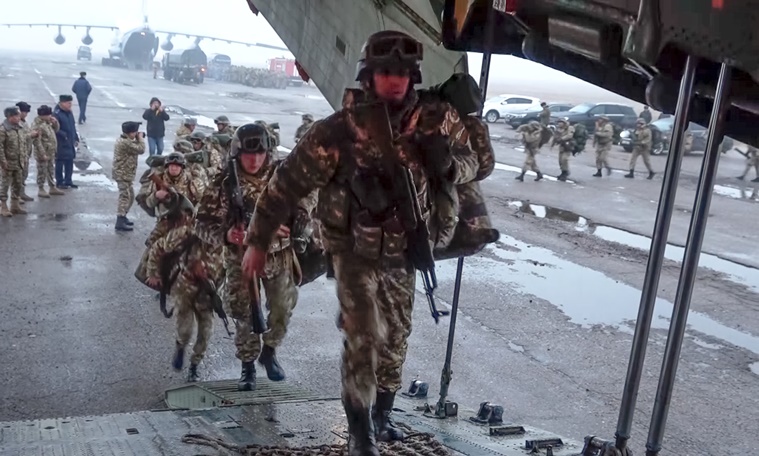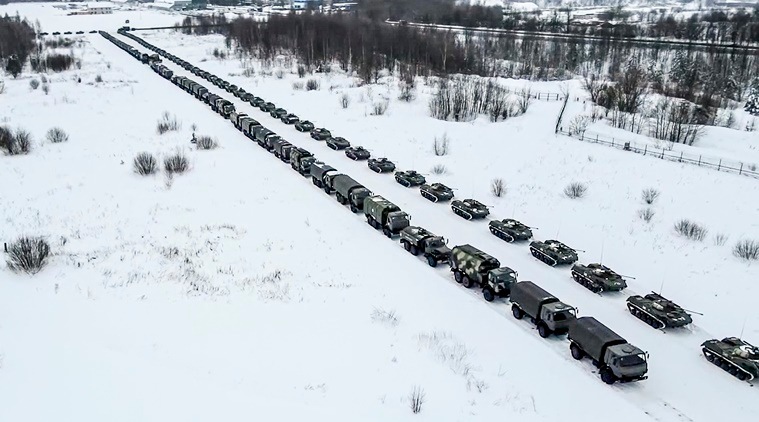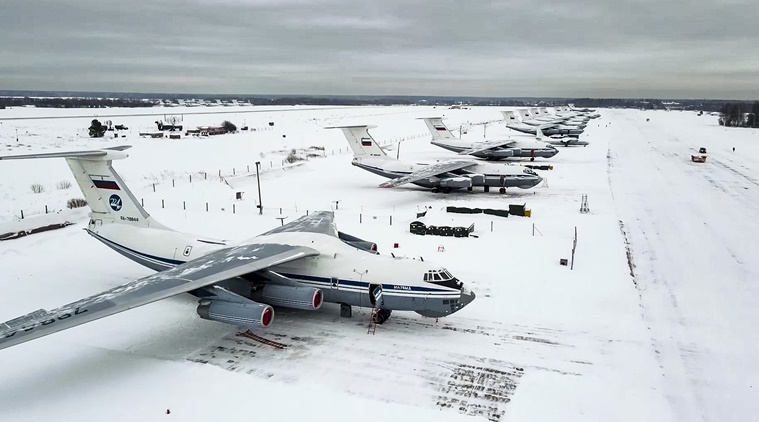Explained: What is CSTO, the organisation helping Kazakhstan President deal with protesters
Kazakhstan's President Kassym-Zhomart Tokayev has called in the Collective Security Treaty Organisation (CSTO) to help quell protests over the hike in fuel prices in the country. What is this group?
 A Kazakhstan soldier stands next to a military vehicle at a check point on Friday. (Photo: AP)
A Kazakhstan soldier stands next to a military vehicle at a check point on Friday. (Photo: AP)Early on January 6, Russian paratroopers and Belarusian special forces were boarding planes for Almaty, one of the largest metropolises of Kazakhstan. The oil-rich country of 19 million people has seen mass unrest in the opening days of the new year over the government’s decision to end subsidies on liquefied petroleum gas.
Although the decision was taken three years ago, on January 1, fuel prices became fully market-based. The cost of LPG, which many Kazakhs use instead of petrol or diesel to run their cars, soon shot up, doubling in some places from 60 tenge ($0.14) a litre at the end of last year to 120 tenge by January 2. Protests immediately broke out in Zhanaozen and it did not take long for them to spread around the vast country, snowballing from a specific grievance about fuel prices into broader demands for regime change.
When things started going out of hand, Kassym-Zhomart Tokayev, the country’s President, called on the Collective Security Treaty Organisation (CSTO) for help. It is soldiers from this group that started storming into the nation to curb the protests which threatened the very existence of the regime that has ruled the Central Asian country since it became an independent republic in 1991.
So, what is the Collective Security Treaty Organisation?
When the Cold War drew to a close in 1991, the Warsaw Pact, an alliance of eight socialist states, and the Soviet Union’s answer to NATO, dissolved. Less than a year later, Russia and five of its allies in the Commonwealth of Independent States, which was nothing but a loose club of post-Soviet countries, signed a new Collective Security Treaty, which came into force in 1994.
Although it wasn’t as powerful as the Warsaw pact, in 2002, as Central Asia loomed larger in geopolitics — America had invaded Afghanistan the previous year — it declared itself the Collective Security Treaty Organisation, a full-blown military alliance. Today it has six members: Armenia, Belarus, Kazakhstan, Kyrgyzstan, Russia and Tajikistan. Uzbekistan had quit the alliance in 2012.
 Peacekeepers board Russian military planes at an airfield outside Bishkek, in Kyrgyzstan on Friday. (Photo: AP)
Peacekeepers board Russian military planes at an airfield outside Bishkek, in Kyrgyzstan on Friday. (Photo: AP)
In the last decade, however, the CSTO’s ambitions have grown. In 2007, it agreed to create a 3,600-strong peacekeeping force and two years later, it established a rapid-reaction force comprising 20,000 elite personnel who are kept on high alert. The alliance has also held joint exercises, including a series of high-profile “anti-terrorism” drills last summer and autumn in response to the growing chaos in Afghanistan.
This week, though, was the first time that the organsation invoked Article 4, which is very similar to NATO’s Article 5. Article 5 says that the response may include armed force, but it does not mandate it. All that NATO actually promises is to take “such action as it deems necessary” to restore and maintain security. That could be anything from nuclear war to a stiff diplomatic protest.
 Military vehicles of Russian peacekeepers waiting to be uploaded on Russian military planes at an airfield in Russia on Friday. (Photo: AP)
Military vehicles of Russian peacekeepers waiting to be uploaded on Russian military planes at an airfield in Russia on Friday. (Photo: AP)
CSTO invoked Article 4 owing to the growing chaos in Kazakhstan as the President blamed foreign-trained “terrorist gangs” for the protests. Nikol Pashinyan, the prime minister of Armenia, which holds the rotating chair of the CSTO, said the group had agreed to send in peacekeepers. In addition to Russia and Belarus, Tajikistan and Armenia also agreed to send contingents.
Russia’s growing influence
For Russia, the CSTO is a useful tool to tighten its grip on Central Asia, against both Western and Chinese encroachments. It justifies Russian military facilities in member countries, while also giving Russia a veto over any other foreign bases in the region. In turn, the CSTO’s members benefit from cooperation with Russia’s advanced armed forces, including training and discounted arms sales.
 Russian military planes parked at an airfield, ready to fly to Kazakhstan. (Photo: AP)
Russian military planes parked at an airfield, ready to fly to Kazakhstan. (Photo: AP)
President Vladimir Putin has long claimed that Kazakhstan, like Ukraine, is not a real country, and instead simply part of the “greater Russian world”.
The alliance’s quick response may be a reassuring sign to the alliance’s other strongmen, including Alexander Lukashenko of Belarus, who received Russian — but not CSTO — assistance last year against his own protesters, and Tajikistan’s Emomali Rahmon, who has been in power for 28 years. In 2010, when Kyrgyzstan sought the group’s help in quelling an outbreak of violence, Russia declined to step in. A decade on, and with wars in Ukraine and Syria under its belt, the Russian influence has only grown.
Newsletter | Click to get the day’s best explainers in your inbox
- 01
- 02
- 03
- 04
- 05






































